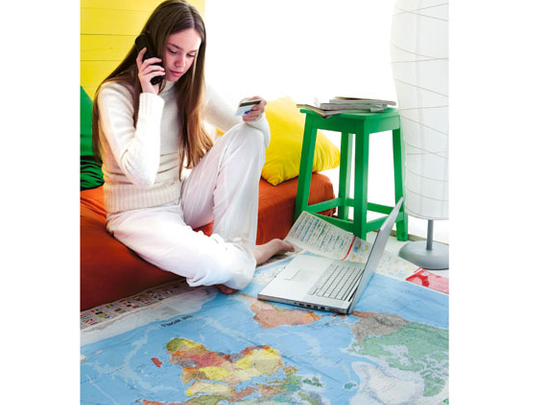
Piggybacking on travel as the preferred reward for most customers, financial institutions are creating sophisticated, super-segmented travel products using newer strategies and data mining. With airlines trying to bring both travellers and non-travellers into their loyalty programmes, travel cards are set to get more attractive for the consumer.
Credit cards co-branded with airline frequent-flyer programmes (FFPs) are used much more than other credit cards — industry estimates suggest the usage is as much as 10 per cent higher. Travel is a very popular motivating reward. From a consumer value proposition, the cost of an upgrade or an airline ticket is perceived to be of high value. However, not all cards are based on the co-branding principle, which works on the monogamous relationship between one credit card and one airline. Last year we saw multiple cards that allow consumers to trade reward points against multiple airline tickets or other travel-related benefits. United Arab Bank (UAB), which launched its travel rewards programme last year in October says that it has paid off.
“We offer rewards redeemable across 300 airlines and 200,000 hotels. Since the launch of this programme we have witnessed an increase in credit card spend by 106 per cent and increase in debit card spend by 50 per cent. Travel rewards is a critical pillar of our customer value proposition,” Tom Smith, Executive Vice-President and Group Head, Retail Banking, UAB, tells GN Focus.
This segmentation translates into customer focus. Card majors say super segmentation and customer-focused strategies will soon be seen across various kinds of products.
This is evident in new launches, strategies and communication with customers. Depending on travel preferences, customers may be able to pick up customised travel cards. Late last year, for the premium segment, MasterCard and First Gulf Bank launched the exclusive World Elite MasterCard Credit Card, which comes with a travel advisor and VIP recognition across the world.
The company also launched the Emirates NBD dnata World MasterCard Credit Card, which packages discounts on tours, car rentals and rewards duty-free shopping with point accelerators. The Qibla card launched by Al Hilal Bank incorporates a digital compass, which at the press of a button locates the direction a Muslim must face while performing prayers. Last December also saw UAE Exchange launch gocash, the region’s first six-currency prepaid travel card, which allows the user to choose from a range of 15 currencies. The Visa Signature premium card launched in the GCC late February, targeting the core affluent market segment, also banks on travel rewards.
“Travel cards are terribly important. Increasingly, you would see an opportunity to create differentiated products based on global best practices. You start at the highest level potentially in, say travel, then you cut a segment, the Islamic segment, for instance. Drill down further to cardholders who are not interested in credit cards and introduce debit cards. We believe that the post-crisis customer is more in control of their finances, more demanding and they need more communication,” Mark Elliott, Senior Business Leader, Product Management, MasterCard tells GN Focus.
Talk to me
Once a card of choice is decided, communication is tailored for the consumer’s unique needs. Rasool Hujair, CEO, Majid Al Futtaim (MAF) Finance, says that creating customised campaigns based on each user’s behaviour is phase one of their ongoing programme for products such as Najm Platinum. “With the data available for three to four years, our system can tell the customer preferences. The system we are building aims to have a built-in intelligence to analyse those details. For instance, we know that you are travelling in July or August. Maybe in June we communicate with you, suggesting ideas.
“We want to be able to distinguish between people who are going home from people going to that destination as tourists. Both may require different things,” says Hujair.
“The system is already used by some websites. The difference between them and us is that the website may only know what books you buy. We know — if we convince you to use your card for everything — almost everything about you. We know, for example, how much you earn, how much you can afford to spend. From your spend we know what restaurants you prefer to dine in, which type of clothes you like. We can take that experience to a different level,” Hujair adds.
Travel statements
Already, a statement is no mere account of where and what you spend on; statements from card companies are now a part of the conversation that is personalised for each customer.
“It is not the same statement for everyone anymore. Since the past month, when UAB sends out a statement, it tells you if you are entitled to go to New York, Beirut or Bangkok with the reward points that you have accrued. We customise the statement for each customer now,” says Smith.For years banks have partnered with frequent-flyer programmes to offer co-branded cards to customers. In the post-financial downturn world, where travel is almost the economic salvation of many companies, things may not remain the same.
“From a loyalty perspective both industries [banking and airlines] are going in different directions. Banks will continue to offer co-branded credit cards as a good value proposition. More banks will launch their own travel rewards.
“On the other side as a commercial opportunity what is trending with a lot of airlines is that they are seeing significant opportunity in setting up their FFP company as a separate one,” says Dion Maritz, General Manager, Middle East, ICLP, a loyalty marketing and customer relationship management company.
Points as real dollars
Convergence may be one of the fallouts. An early example of this is the Air New Zealand OneSmart card, issued to about 700,000 frequent flyers in November 2011.
The card doubles as a digital boarding pass and MasterCard travel money card. Says Maritz, “What used to be a plastic membership card is now a prepaid card, in which points are real dollars and can be used to purchase anything.”








